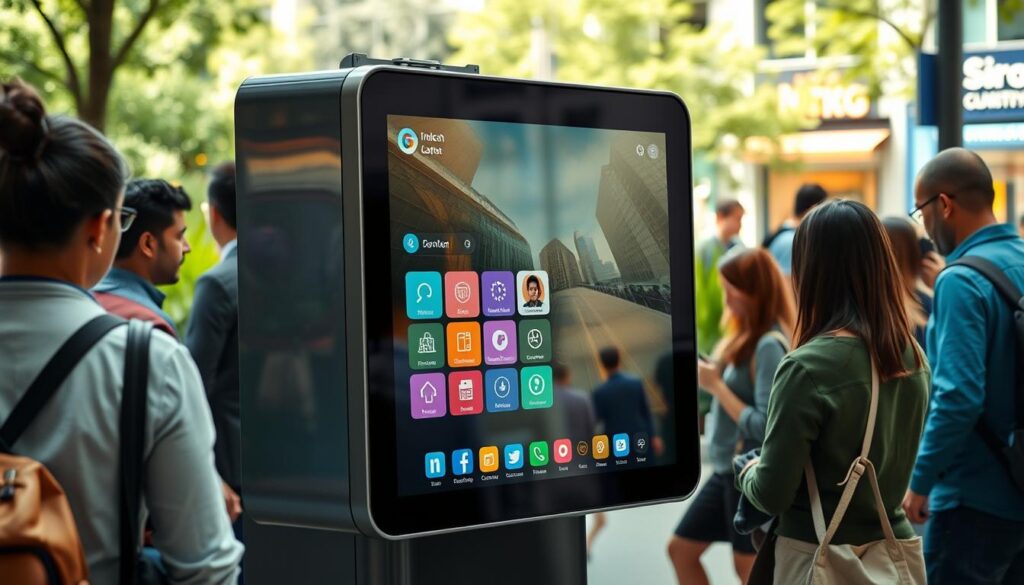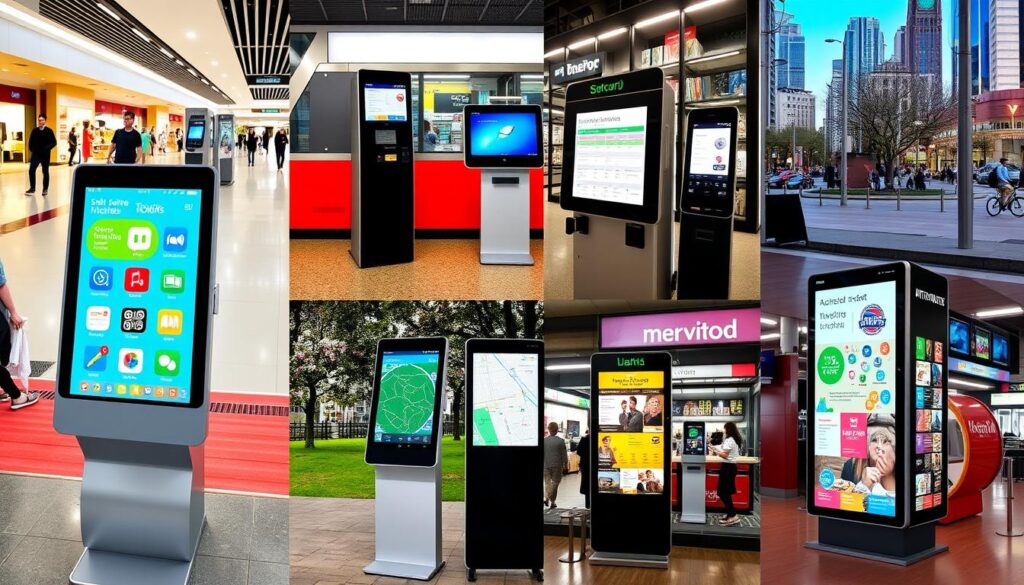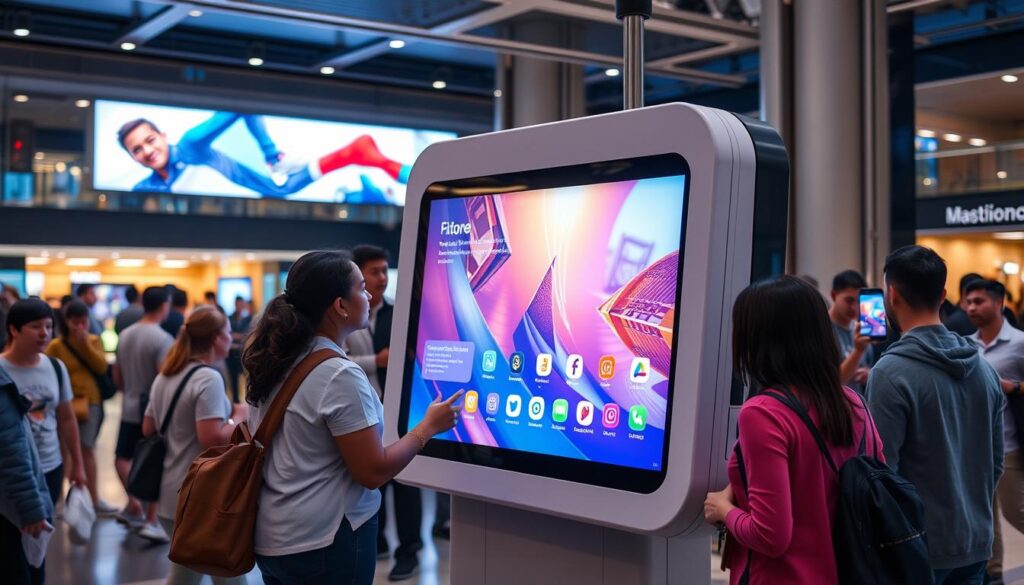In today’s fast-paced world, touch screen kiosk software is key to better user interactions. You find them in retail stores, healthcare, and transportation hubs. They make things easier and faster for everyone. The market for these kiosks is growing fast, expected to hit USD 48.8 billion by 2029.
These kiosks come in all sizes, from small tablets to big screens. They use special touchscreens that feel natural to use. Now, you can swipe and pinch to move through content easily.
Kiosk software solutions make things better for customers and save businesses money. They help speed up transactions and make things more efficient. As technology gets better, we can expect even more cool features in digital kiosk software.

Key Takeaways
- Touch screen kiosks enhance user experience across multiple sectors.
- The market for interactive kiosks is projected to grow significantly within the next few years.
- Innovative technologies like capacitive touchscreens and multi-touch capabilities improve usability.
- Touch screen kiosks reduce operational costs by automating routine tasks.
- Ongoing advancements in kiosk software will further enhance interactive experiences.
2. Key Features of Touch Screen Kiosk Software
Touch screen kiosk software has many features that make it easy to use. Businesses want to make sure their kiosks are user-friendly. This means adding key features that make the experience smooth.
Intuitive Navigation and User-Friendly Design
Navigation is key for a good user experience. The software should let users move around easily. A clear design and simple steps help users get started quickly.
Branding and Theme Options
Custom branding lets businesses keep their look. They can change themes to match their brand. This makes the kiosk look professional and trustworthy.
Accessibility Features (font size, contrast, multi-language support)
Accessibility features are important for all users. Options like font size and contrast help everyone. Multi-language support also makes the kiosk more inclusive.
Gesture Support (tap, swipe, pinch, zoom)
Gestures make the system more interactive. Touch screen kiosk software should support gestures like tap and swipe. This makes it fun to use and interact with.
3. Types of Touch Screen Kiosks and Applications
Touch screen kiosks are used in many ways to make things easier and more fun. They help in different fields, making them very useful. Let’s look at the main types of touch screen kiosks:
Self-Service Kiosks
Self-service kiosks are found in stores, restaurants, and ticket booths. They let customers do things on their own, like buying things or ordering food. Using these kiosks can cut down wait times by 30%, making people happier.
Businesses see a big jump in sales, up to 30%, when they use these kiosks.
Information Kiosks
Information kiosks are great in museums, government buildings, and public areas. They give important info and help people find their way. The software used in these kiosks supports many languages and makes things easier for everyone.
In places like libraries and malls, these kiosks are very important.
Interactive Kiosks
Interactive kiosks make things fun by letting users touch screens. They can show products, do surveys, or teach things. These kiosks make people remember brands better, with a 48% increase in awareness.
They can even have games, keeping users interested and learning.
Check-in Kiosks
Check-in kiosks make things easier in healthcare and travel. They help with patient check-ins at hospitals or passenger check-ins at airports and hotels. Using these kiosks makes things faster and more efficient.
As we use more technology, the need for these kiosks grows. They show how we’re moving towards digital solutions in our daily lives.

4. Choosing the Right Touch Screen Kiosk Software
Choosing the right touch screen kiosk software is key. First, figure out what the kiosk will do. Will it show information, handle transactions, or entertain users?
Purpose and Functionality of the Kiosk
The kiosk’s purpose affects the software choice. For example, retail kiosks need to process transactions. On the other hand, info kiosks should give directions or teach something. The right software makes the kiosk work well.
Hardware Compatibility and Operating System
It’s important for the software to work with your hardware. Check if the software fits with your system and user interface. This ensures the kiosk works smoothly and users are happy.
Software Features and Customization Options
Software should be flexible to fit your needs. It should let you add your brand, personalize it, and offer various features. Good software lets you customize for different users.
Budget, Scalability, and Deployment Size
Cost is a big factor in choosing software. Look at what you get for your money. Also, think about how easy it is to grow or change your setup. Scalable software helps you expand without a big cost.
5. Top Touch Screen Kiosk Software Providers
The demand for interactive kiosk software has grown a lot in many industries. This has led to the rise of several top software providers. Each one offers special features to improve user experience and make operations more efficient. Here, we highlight some of the key players in the touch screen kiosk system market.
Kiosk Information Systems
Kiosk Information Systems is a leader in the interactive kiosk industry. They offer strong solutions for retail, healthcare, gaming, and more. Being part of the Posiflex group, they bring cutting-edge technology to their products.
Their kiosk management software makes operations smooth across different sectors. It supports payment, ticketing, and check-in functions.
Meridian
Meridian was founded in 1999 and specializes in indoor and outdoor kiosks. Their systems support payments in automotive, hospitality, and corporate settings. They operate from a large campus in North Carolina.
They focus on making durable and versatile solutions. This makes them a trusted choice for retail and entertainment.
Redyref
Redyref is known for its interactive kiosks in various industries. They offer a wide range of self-service and information kiosks for retail, food service, and self-ticketing. Their customizable kiosk management software helps businesses create a unique experience for their customers.
Advanced Kiosks
Advanced Kiosks is based in Concord, NH. They provide custom hardware and software solutions for different kiosk types. They focus on making sure clients get the exact kiosk systems they need.
Their solutions improve user engagement and streamline functions across industries.
LamasaTech
LamasaTech has over 11 years of experience in innovative kiosk solutions. They offer touchscreen stands, video walls, and holographic displays. Their kiosks are designed for applications like wayfinding and surveys.
Their kiosk management software works well with their hardware. This provides a complete solution for businesses looking to enhance customer interaction.

| Provider | Year Established | Industries Served | Key Features |
|---|---|---|---|
| Kiosk Information Systems | 1993 | Retail, Healthcare, Gaming | Multi-functional kiosks |
| Meridian | 1999 | Automotive, Corporate, Hospitality | Indoor & Outdoor kiosks |
| Redyref | 2000 | Retail, Food Service | Self-service kiosks |
| Advanced Kiosks | 2001 | Retail, Ticketing | Custom hardware/software solutions |
| LamasaTech | 2012 | Tourism, Surveys | Innovative interactive displays |
6. Designing Effective Touch Screen Kiosk Interfaces
Creating great touch screen kiosk interfaces means knowing what users need and how they interact. Good design makes getting information easy and straightforward. Here are some key areas to focus on:
Usability Principles for Touchscreens
Touch screen kiosk software should be easy to use. It should have clear navigation, visual hints, and not too much text. Clear buttons and icons help users find their way, and simple instructions make things clearer. This way, users are happy and stay engaged.
Visual Design and Layout
How something looks is important for keeping users interested. Choosing the right colors, fonts, and images is key. A clean layout with enough space helps users focus. Designs that work well on different devices are also important.
Content Optimization for Touch Interaction
Digital kiosk software should share information in a clear way. It should also have interactive parts to keep users involved. Simple actions like tapping and swiping should make it easy to move around and explore. Adding multimedia can make learning more fun and effective.
Accessibility Considerations
It’s important to make touch screen kiosks accessible to everyone. This means paying attention to font sizes, contrast, and other ways to interact. Adding audio descriptions and support for screen readers helps a lot. This way, more people can use the kiosks.
| Design Element | Best Practices | Benefits |
|---|---|---|
| Navigation | Clear buttons, consistent layout | Reduces user frustration, enhances efficiency |
| Visual Cues | Color coding, icons, animations | Guides users effortlessly, improves interaction |
| Content Presentation | Conciseness, multimedia | Engages users, retains information better |
| Accessibility Features | Adjustable text sizes, audio support | Ensures inclusivity, broadens audience reach |
7. Deploying and Managing Touch Screen Kiosks
Deploying and managing touch screen kiosks requires careful planning. It’s important to focus on installation, content management, training, and maintenance. This ensures kiosks work well and meet their goals. A good plan helps improve customer interaction and satisfaction.
Installation and Configuration
Setting up kiosks starts with the right hardware and software setup. Choose digital kiosk software that fits your kiosk’s needs. Key steps include:
- Hardware setup: Make sure screens and processors meet the minimum specs, like an Intel i3 CPU.
- Software installation: Pick kiosk management software that’s easy to use and secure.
- Network connectivity: A stable network is key for updates and monitoring.
Content Creation and Updates
Creating engaging content is vital for kiosk success. Interactive kiosk software can make content more interactive. Regular updates keep content fresh. Consider these tips:
- Design content that grabs attention and is easy to navigate.
- Use software that makes updates simple, without long downtime.
User Training and Support
User training is key for smooth integration. Good onboarding materials help staff and customers. Important steps include:
- Make FAQs and help desk resources for common issues.
- Provide training videos and live support to boost user confidence.
Maintenance and Troubleshooting
Regular maintenance keeps kiosks running smoothly. Without it, kiosks can fail or underperform. Here are some maintenance tips:
- Regularly update software with security patches and new features.
- Use remote monitoring tools for quick issue solving and performance tracking.
By focusing on these key areas, businesses can get the most from their kiosk software. This ensures a reliable and engaging user experience.
8. The Future of Touch Screen Kiosk Software
The world of touch screen kiosk software is about to change a lot. New technologies and ways to interact are coming. By 2024, the sales of interactive kiosks could hit $30.3 billion.
Now, companies are adding cool stuff like AI, AR, VR, voice control, and gesture recognition. These features make using kiosks easier and more fun.
Emerging Technologies
AI makes kiosks more personal for customers. AR and VR bring users into new worlds. Voice control and gesture recognition make things easier and more accessible.
These changes are making kiosks smarter and more like what people want today.
Trends in Touchscreen Interaction
New trends like haptic feedback, curved displays, and transparent screens are changing how we interact. These changes are making digital and physical worlds blend together.
Kiosks are now more than just for buying things. They offer safe, easy ways to get what you need. This is key in today’s world.
The Role of Kiosks in a Changing World
More businesses are using touch screen kiosk software. This makes things run smoother and keeps customers happy. The market for these kiosks is growing fast.
Companies are always looking to make kiosks better. They’re becoming essential for businesses to stay ahead. With uses from health records to POS systems, the future is bright.
FAQ
What is touch screen kiosk software?
Touch screen kiosk software is a platform for kiosks. It makes using kiosks easier by guiding users through certain actions. It’s great for places like stores, hotels, and hospitals.
What are the key features of touch screen kiosk software?
Important features include easy navigation and the ability to change how it looks. It also has features for everyone, like big fonts and many languages. Plus, it supports gestures like tapping and swiping.
What types of touch screen kiosks exist and where are they used?
There are many types of kiosks. Self-service kiosks help with payments and tickets. Information kiosks guide you around and teach you things. Interactive kiosks show fun content. Check-in kiosks make processes easier in healthcare and travel.
How do I choose the right touch screen kiosk software?
First, think about what the kiosk will do. Check if the software works with your hardware. Look at the software’s features and how you can change it. Also, think about your budget to make sure it fits your needs.
Who are the leading providers of touch screen kiosk software?
Top providers include KioWare for secure browsers, Intuiface for rich media, and ScreenCloud for digital signage. Each offers something special for interactive kiosks.
What should I consider when designing a touch screen kiosk interface?
Good design is easy to use and looks nice. Use clear colors and fonts. Keep content short and fun. Make sure it works for everyone.
What steps are involved in deploying and managing touch screen kiosks?
First, set up the hardware and software. Then, make and update content. Train users and offer support. Regularly check and fix the kiosk to keep it working well.
What future trends are impacting touch screen kiosk software?
New trends include AI and AR/VR for better experiences. There will be new ways to interact with screens and displays. Also, we’ll see more contactless and personalized services.